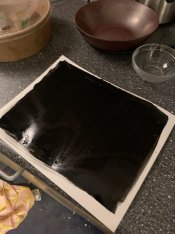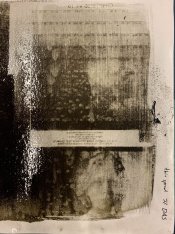holmburgers
Member
If you're not familiar with 4,4'-Diazidostilbene-2,2'-disulfonic acid, disodium salt, tetrahydrate, it's much easier to call it DAS, or the amazing azide sensitizer that was used in the UltraStable process and which is currently being used by the world's leading color-carbon printer, Tod Gangler.
This sensitizer is a non-carcinogenic and non-toxic alternative to the dichromates historically used in carbon printing (potassium, ammonium, etc.) and similar processes ((there was a url link here which no longer exists), PVA, probably more). In addition to being environmentally friendly and safe to work with, it has no "dark reaction" like the dichromates. What this means it that tissues can be made with incorporated sensitizer (pre-sensitized) and they will keep for long periods of time. UltraStable tissues from the mid-90's will still make prints today.
Although I can't give any hard facts or guarantees at the moment, all the information we've been seeing tells us that pre-sensitized tissues should keep on the scale of years, depending on humidity and temperature. Refrigerated tissues should keep well for several years and frozen tissues... who knows.
Differences in working technique with DAS are minimal. The manner in which the sensitizer is incorporated into pigmented gelatin or "glop" is elucidated (there was a url link here which no longer exists), and there is a simple clearing bath ((there was a url link here which no longer exists)) which uses a minute amount of potassium permanganate. Also, the sensitizer powder should be refrigerated and kept away from light. With refrigeration it will keep well, even better with freezing (the manufacturer has kept this stock frozen since 2006 and its properties have not changed). Detailed information about the sensitizer will be included with all orders.
As an incorporated sensitizer it's recommended to use DAS at 0.6% as a starting point. For 500mL of pigmented gelatin, that's only 3 grams of sensitizer. Contrast is affected by changes in sensitizer concentration, just like dichromates. I believe that printing times are generally a bit longer however. DAS is sensitive to UV light just like the dichromates (its sensitivity peak is 335nm).
Tod Gangler personally tested this batch of sensitizer and gave it his approval. A great debt is owed to Tod and Charles Berger for sharing their experience with this sensitizer amongst the carbon community. Many others here on APUG have done a lot of digging, reading and experimenting to pave the way for this group buy; many thanks to them too! (you know who you are ) (there was a url link here which no longer exists) has been the clearing house for most of this information.
) (there was a url link here which no longer exists) has been the clearing house for most of this information.
------------------------------------------------------------------------------------------------------
The price is 20¢/gram, or $200/kg, plus shipping & packaging (email me for an estimate). International shipping is welcome! This chemical is not considered hazardous by any international transit authority and should not cause troubles. However, I recommend that you attempt to confirm that this is the case in your country if at all possible, just as a precaution. The CAS# is 2718-90-3.
The minimum quantity is 100 grams and international orders are limited to 1kg. I would prefer check or money order on domestic orders, but Paypal is OK with a little bit extra to cover the fees.
The DEADLINE for this order is January 27th at 11PM EST. This is when I will be placing the final order with the supplier and also for the packaging supplies. This means that orders won't be shipped until a couple of weeks into February. I apologize for this long delay, but it's the nature of this wholesale buy and the fact that I have to repackage it.
This is a rare opportunity to get in on the ground floor of a revolution in alternative processes! There will of course be a learning curve, but the beauty of this group buy is that it will put the sensitizer in the hands of many people for the first time at once, and as a community we can all learn collectively how best to approach this new way of working.
Please do not PM me if you can help it; email is a much more reliable method of communication for me these days - holmburgers(at)yahoo(dot)com
2% of classifieds sales go to APUG.
Thank you!
Chris H.
This sensitizer is a non-carcinogenic and non-toxic alternative to the dichromates historically used in carbon printing (potassium, ammonium, etc.) and similar processes ((there was a url link here which no longer exists), PVA, probably more). In addition to being environmentally friendly and safe to work with, it has no "dark reaction" like the dichromates. What this means it that tissues can be made with incorporated sensitizer (pre-sensitized) and they will keep for long periods of time. UltraStable tissues from the mid-90's will still make prints today.
Although I can't give any hard facts or guarantees at the moment, all the information we've been seeing tells us that pre-sensitized tissues should keep on the scale of years, depending on humidity and temperature. Refrigerated tissues should keep well for several years and frozen tissues... who knows.
Differences in working technique with DAS are minimal. The manner in which the sensitizer is incorporated into pigmented gelatin or "glop" is elucidated (there was a url link here which no longer exists), and there is a simple clearing bath ((there was a url link here which no longer exists)) which uses a minute amount of potassium permanganate. Also, the sensitizer powder should be refrigerated and kept away from light. With refrigeration it will keep well, even better with freezing (the manufacturer has kept this stock frozen since 2006 and its properties have not changed). Detailed information about the sensitizer will be included with all orders.
As an incorporated sensitizer it's recommended to use DAS at 0.6% as a starting point. For 500mL of pigmented gelatin, that's only 3 grams of sensitizer. Contrast is affected by changes in sensitizer concentration, just like dichromates. I believe that printing times are generally a bit longer however. DAS is sensitive to UV light just like the dichromates (its sensitivity peak is 335nm).
Tod Gangler personally tested this batch of sensitizer and gave it his approval. A great debt is owed to Tod and Charles Berger for sharing their experience with this sensitizer amongst the carbon community. Many others here on APUG have done a lot of digging, reading and experimenting to pave the way for this group buy; many thanks to them too! (you know who you are
 ) (there was a url link here which no longer exists) has been the clearing house for most of this information.
) (there was a url link here which no longer exists) has been the clearing house for most of this information.------------------------------------------------------------------------------------------------------
The price is 20¢/gram, or $200/kg, plus shipping & packaging (email me for an estimate). International shipping is welcome! This chemical is not considered hazardous by any international transit authority and should not cause troubles. However, I recommend that you attempt to confirm that this is the case in your country if at all possible, just as a precaution. The CAS# is 2718-90-3.
The minimum quantity is 100 grams and international orders are limited to 1kg. I would prefer check or money order on domestic orders, but Paypal is OK with a little bit extra to cover the fees.
The DEADLINE for this order is January 27th at 11PM EST. This is when I will be placing the final order with the supplier and also for the packaging supplies. This means that orders won't be shipped until a couple of weeks into February. I apologize for this long delay, but it's the nature of this wholesale buy and the fact that I have to repackage it.
This is a rare opportunity to get in on the ground floor of a revolution in alternative processes! There will of course be a learning curve, but the beauty of this group buy is that it will put the sensitizer in the hands of many people for the first time at once, and as a community we can all learn collectively how best to approach this new way of working.
Please do not PM me if you can help it; email is a much more reliable method of communication for me these days - holmburgers(at)yahoo(dot)com
2% of classifieds sales go to APUG.
Thank you!
Chris H.











